Industrialization
Eskilstuna Fristad merged with Eskilstuna in 1833 under the name Eskilstuna (fri)stad. Tunafors was not incorporated until 1907.
Each company manufactured hundreds of different items of iron and other metals, as well as a variety of door locks, chamber locks, padlocks, and door fittings.
It wasn’t until the industrial improvements of the mid-1800s that these companies’ manufacture of ironware finally took off.
Locksmiths in the 1820s
In the 1820s, most of the 77 masters and locksmith widows worked with the manufacture of locks and knives. More accurately, the locks were made by 16 masters and two widows. Jonas Bergström, M R Eklund, Eric Eriksson (who manufactured Polhem padlocks), Eric Grytzell, Johan Johansson, Anders Körling, Eric Ljusberg, C F Lundberg, P A Lundberg, Anders Lundqvist, Eva Margareta Ramström (locksmith widow), P G Reutermark, Catharina Sundberg (locksmith widow), and Anders Svahn.
Eskilstuna’s lock makers
The Stenman Family
August Stenman (1852–1920) was the son of lock-maker Frans August Stenman of Eskilstuna. In 1877, after having studied in Germany, the UK, and the United States, August returned to his home town, where he was employed at the new Jernbolaget factory in Tunafors. In 1881, after two years as foreman there, Stenman bought Thunell’s hinge factory.
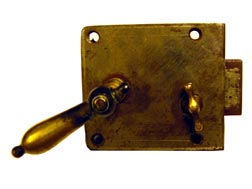 |
| Door lock, chamber lock, E A Stenman (19th C). Photo by the author. |
At this time, the company changed its name to Stenman’s hinge and construction ironware factory. Stenman built up the company by installing the most efficient machines he could find on the market, as well as his own personally developed machines for mass-producing locks.
The author has written a separate article on the Stenman family.
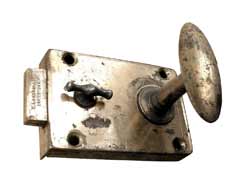 |
| Door lock, chamber lock, E A Næsman (19th C). Photo by the author. |
E A Næsmans Låsfabrik
In 1814, Lars Erik Næsman arrived in Eskilstuna as a blacksmith’s apprentice and became a locksmith. Thirty-two years later, his son Erik Augustinius Næsman (1824–1894) set himself up as a factory owner manufacturing rifle components, bayonets, bridle bits, stirrups, chains, and locks. In 1881, the company was taken over by August Ståhlberg, eventually becoming part of the Låsfabriksaktiebolaget company.
The Ståhlberg Family
Soldier and knife smith Anders Diurman (1780–1848) came from outside Eskilstuna in Djursta. His son Anders (1780–1848) adopted the name Ståhlberg and in 1812 teamed up with Christoffer Zetterberg to start a company that manufactured and sharpened knives. They remained partners for a year, then Anders Ståhlberg continued to manufacture knives on his own in his own company, Låsfabriks Aktiebolaget (or Låsbolaget), which he founded in 1846.
Son 1. Lars Fredrik Ståhlberg (1812–1890) took over his father’s workshop and his son, Lambert, took over after him (Lars Fredrik). In 1915, the company was sold to Eskilstuna Jernmanufaktur AB.
Son 2. Carl Erik Ståhlberg (1832–1868) also started out in his father’s workshop. He started his own table knife factory, which closed down on his death. His son, August Ståhlberg (1852–1931), returned to Eskilstuna in 1881, most recently from the Husqvarna munitions factory, where he had advanced to the position of factory manager.
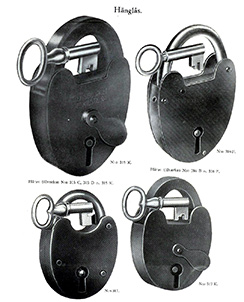 |
| Padlocks, Låsfabriks AB, circa 1900 |
He took over the lock company in 1881, renaming it E A Næsman & Co. On his death, the company was passed down to his son, Harald Ståhlberg (1877–1945), who was succeeded by his sons Gunnar and Erik. Some time since then, the name was changed to Låsfabriks Aktiebolaget, or “Låsbolaget.”
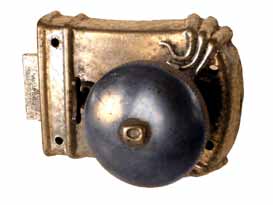 |
| Door lock, chamber lock, E A Næsman (19th c.). Photo by the author. |
Christoffer Zetterberg
Christoffer Zetterberg (1775–1852) was a maker of padlocks and other metalwork wares. His company, founded in 1811, made padlocks, sabers, foils, and knives. For a year between 1812 and 1813, Zetterberg and Anders Ståhlberg were partners. On Zetterberg’s death, the company was taken over by Johan Svenngren (1818–1905), who went on to found the Eskilstuna Jernmanufakturaktiebolag (Jernbolaget) in 1868.
Other companies
Johan Hedlund, 1817–1880. Production included padlocks (Polhem and other types).
Johan Walén, 1820–1881. Started operating in 1846. Production included door locks and padlocks (including Polhem locks).
Locksmiths from 1850 to 1900
C A Lundberg, JA Lundberg, Sven Ulander, A Chorell’s widow, P G Julin, C Stenberg, P Carlsson, J Strömvall, PG Broselius, A G Kjellgren, Carl Chorel, Otto M Fröberg, J Hedin, Jac Fr Hellstedt. J J Blomster and L E Nordström made spring latch locks (combined latch bolt and dead bolt) and Johan Hedlund, J P Häggvall, E Otto Grytzell and Adolf Ståhl made Polhem padlocks.
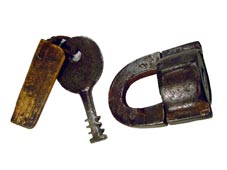 |
| Polhem padlock from the mid-19th C. Photo by the author. |
In 1875, many companies were involved in the manufacture of locks. Jernbolaget (which made various kinds of locks and scissors), H Lagerbäcks Låsfabrik, S J Thelin’s lock workshop, Eskilstuna Låsfabrik, and P August Karlssons Låsfabrik.
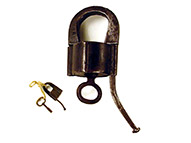 |
| Two Polhem padlocks by Adolf Ståhl from the late 19th C. Photo by the author. |
The 1851 World’s Fair in London’s Hyde Park
Among the exhibitors from Eskilstuna were locksmiths C A Lundberg and Sven Ulander, as well as factory owners Johan Hedlund and Johan Walén, who both tried to introduce Polhem padlocks onto the central European market.
How were the products sold?
The goods reached the market through what was known as the putting-out system, an organizational form for the production and distribution of goods. It was the dominant form of production prior to the breakthrough of the factory system. As an industrial organizational method, the putting out of goods in Europe dates back to the Middle Ages. In its simplest form, a tradesman, trading firm, or “putter-out” provided the manufacturers with raw materials or semi-manufactured goods along with the necessary credit, and they, in turn, produced the final products. The putter-out then sold the items on the domestic market and sometimes on export. The Eskilstuna companies found themselves facing stiff competition from their putters-out and their imported foreign wares.
The companies also had to compete with their own workers, who would try to supplement their wages by selling or bartering with the public or tradesmen. The items were either taken from the factory or were made in secret on the side and at the company’s expense. This was considered counterfeiting, and turned out products of inferior quality that could damage the company’s reputation if they carried the company stamp.
I would hereby like to remind each and every one who is in the business of purchasing metalware products not to engage with my workers in any kind of trade of Polhem padlocks or of any other metalwork items manufactured in my factory, since I strictly prohibit such trade, by virtue of its being fraudulent.
Eskilstuna, March 7, 1846. Joh. Hedlund
Lock factory owner Hedlund’s announcement was also directed at itinerant traders (peddlers or hawkers) who competed with the putters-out, iron traders, and the factory’s own sales. The traders frequented the factories and inns, buying or trading finished products directly from the workers. They then withdrew into the countryside to sell the items directly to farmers and villagers, or sold them at the local annual markets.